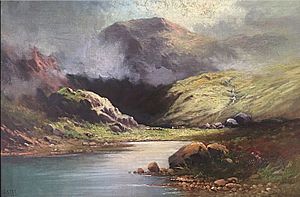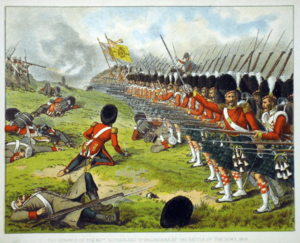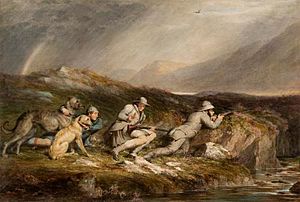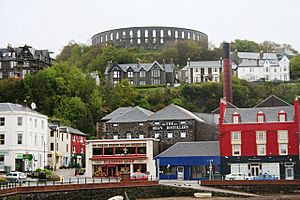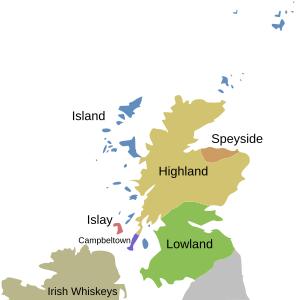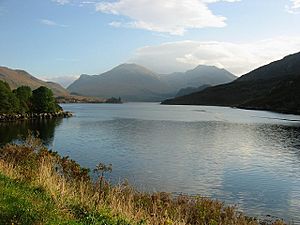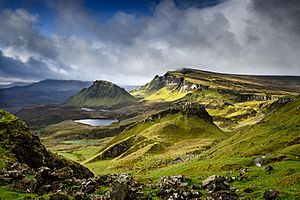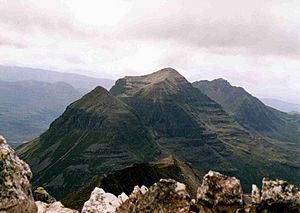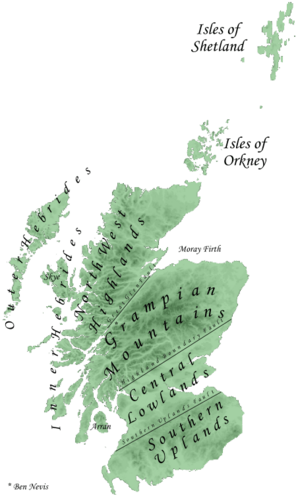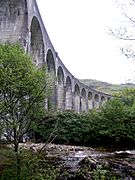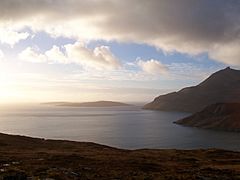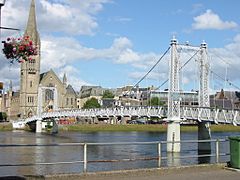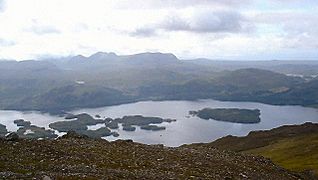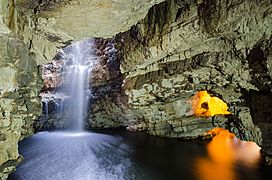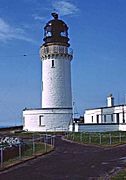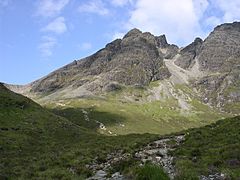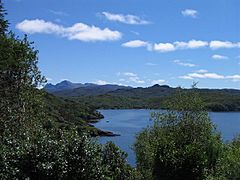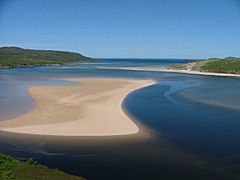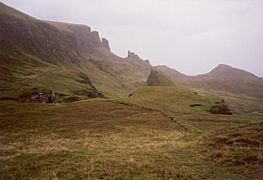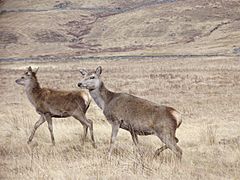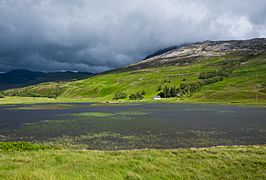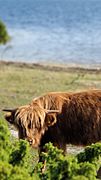Scottish Highlands facts for kids
Quick facts for kids
Highlands
|
|
|---|---|
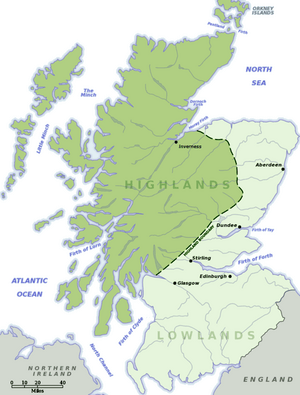
Lowland–Highland divide
|
|
| Seat | Inverness |
| Population | |
| • Estimate
(2019)
|
600,000 |
| Demonym(s) | Highlander |
| Time zone | GMT/BST |
The Highlands are a beautiful and historic part of Scotland. In Scottish Gaelic, this area is called Scottish Gaelic: a' Ghàidhealtachd, which means "the place of the Gaels". For a long time, the Highlands were culturally different from the Lowlands. This was mainly because people in the Highlands spoke Scottish Gaelic, while those in the Lowlands spoke Lowland Scots.
The Highlands are mostly north and west of the Highland Boundary Fault. This is a long line that runs across Scotland. The exact borders of the Highlands can be a bit unclear. The Great Glen, a famous valley, splits the Grampian Mountains from the Northwest Highlands.
This region is very spread out, with not many people living there. It has many mountain ranges, including Ben Nevis, the highest mountain in the British Isles. In the 18th and 19th centuries, many people moved away from the Highlands. They went to countries like Canada, the United States, and Australia. Some also moved to big cities in Scotland and England. This is why the Highlands are now one of the most thinly populated areas in Europe.
The Highland Council helps manage a large part of the Highlands. Its main office is in Inverness. However, the Highlands also include parts of other areas like Aberdeenshire and Perth and Kinross. The Scottish Highlands are special because they are the only place in the British Isles with a taiga biome. This means they have many Scots pine forests, like the Caledonian Forest. It is also the most mountainous part of the United Kingdom.
Contents
History of the Highlands
Highland Culture
For many centuries, the Highlands had a different culture and language from the Lowlands. People in the Highlands traditionally spoke Scottish Gaelic. Today, Gaelic is mostly spoken in The Hebrides, which are islands off the west coast. The terms "Highlands" and "Gàidhealtachd" are sometimes used for the same area, but they mean different things in their languages.
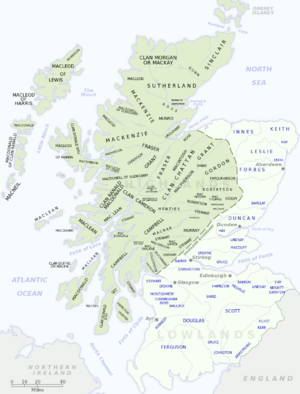
Historically, the main social group in the Highlands was the clan. Each clan was like a large family, led by a chief. Scottish kings, like James VI, saw the clans as a challenge to their power. Many people thought the Highlands were a wild area. Lowlanders often saw Highlanders as old-fashioned and more like the Irish.
Over time, clan chiefs started to act more like landlords. They began asking for money for rent instead of goods. Rents went up as landowners wanted more money. This led to the Highland clearances between 1760 and 1850. During this time, many people were forced to leave their homes. Their land was then used for large sheep farms. The people who were moved often became crofters. Crofts were small farms that were not big enough to support a family fully. Crofters often had to find other jobs, like fishing. This also encouraged them to learn English, which was seen as the "language of work."
After the Jacobite rising of 1745, the British government tried to control the clan system. They banned carrying weapons and wearing tartan. But by the late 1700s, most of these laws were removed. Highland culture then became popular again. Tartan was used for Highland regiments in the British Army. Many poor Highlanders joined the army during the wars around 1790–1815.
Even though ordinary people had stopped wearing tartan, it became popular again in the 1820s. People across Europe, not just in Scotland, started wearing tartan and the kilt. This was partly thanks to stories like the Ossian cycle and the books of Walter Scott. When King George IV visited Scotland in 1822 and wore tartan, it made kilts and tartans even more popular. Different clan tartans were created around this time. They became a big symbol of Scottish identity. This idea of "Highlandism," where all of Scotland was linked to Highland culture, became even stronger when Queen Victoria became interested in Scotland. She made Balmoral a royal home and loved "tartenry."
Economy and Industry
For much of its history, the Highlands faced repeated periods of famine. This happened as late as the 1850s in some areas. In the 1700s, the region traded black cattle with the Lowlands. This trade was important for getting enough food. Most of the Highlands, especially in the North and West, did not have much land suitable for farming. Only about 9% of the land in the Highlands can be farmed.
Between the 1760s and 1830s, there was a lot of illegal whisky made in the Highlands. This whisky was not taxed, so it was cheaper. Lowland distillers complained that Highland whisky made up more than half of the market. This shows that people in the Highlands were good at finding ways to make money.
New farming methods arrived in the Highlands between 1760 and 1850. Landowners, who often had many debts, wanted to make more money from their land. In the East and South, farming changed like it did in the Lowlands. Larger farms were created, and old fields were fenced off. New crops like turnips were introduced. This led to more Highland clearances, as many tenants were forced to leave. Some found work on the new, larger farms, while others moved to towns in the Lowlands.
In the West and North, people who were moved were often given small farms called crofts. Their old land was turned into large sheep farms. Sheep farmers could pay much higher rents. Crofts were small, so people had to find other jobs. Fishing and the kelp industry (making products from seaweed) were common. Landlords controlled the kelp shores and took a large part of the money earned by their tenants.
After the Napoleonic Wars ended in 1815, the Highland economy suffered. The price of black cattle and kelp fell sharply. Wool prices also dropped. This made the financial problems of landowners even worse. Then, in 1846, potato blight hit the Highlands. This destroyed the main food crop for many crofting communities. The government told landowners they had to help their tenants during the famine. Many Highland estates were sold because landowners could not afford the relief efforts. Those who had sheep farms were better off. The government offered loans for things like drainage and road building. Many crofters also went to the Lowlands for temporary work. This became a common pattern of working away from the Highlands.
The issue of who owned the land remained very important. Poor crofters had little power. Many turned to religion, joining the Free Church after 1843. This religious movement was led by local preachers who often criticized the powerful landowners. This helped the crofters become more organized. In the 1880s, they challenged the landlords through the Highland Land League. There was some violence, especially on the Isle of Skye, when landlords cleared land for sheep and deer. The government stepped in and passed the Crofters' Holdings (Scotland) Act, 1886. This law lowered rents, gave crofters more secure rights to their land, and helped break up large estates to provide crofts for those without homes. Three Crofter candidates were even elected to Parliament in 1885. The Crofters' political movement faded by 1892, and their votes went to the Liberal Party.
Whisky Production
Today, the Highlands are the biggest Scotch whisky producing region in Scotland. This area stretches from Orkney in the north to the Isle of Arran in the south. It includes many islands and parts of the mainland. There are over 30 distilleries in this huge area. Some of the most famous are The Macallan, Glenfiddich, and Aberlour.
Even though Speyside is geographically in the Highlands, it is considered a separate region for whisky. Speyside has about 50 distilleries. According to Visit Scotland, Highlands whisky is "fruity, sweet, spicy, and malty." Whiskies from the Northern Highlands are often "sweet and full-bodied." Those from the Eastern and Southern Highlands tend to be "lighter." Whiskies from the Western Highlands often have a "peatier" taste.
Religion in the Highlands
The Scottish Reformation had some success in the Highlands. However, Roman Catholicism stayed strong in some remote areas. This was thanks to missionaries from Ireland. There are still many Catholic communities in the Highlands and Islands, like Moidart and Morar on the mainland, and South Uist and Barra in the Outer Hebrides.
Because the region was so remote and there were few Gaelic-speaking clergy, the main church had trouble spreading its message. But in the late 1700s, things changed after the Battle of Culloden in 1746. In the 1800s, the Free Churches, which accepted Gaelic language and culture, grew quickly. They were much more popular than the established church.
Today, most of the Highlands are Protestant, belonging to the Church of Scotland. However, the northern Outer Hebrides islands (Lewis, Harris, and North Uist) have many people who belong to the Protestant Free Church of Scotland or the Free Presbyterian Church of Scotland. The Outer Hebrides are sometimes called the last place in Britain where Calvinism is very strong. The Sabbath (Sunday) is still widely observed there. In Inverness and the surrounding area, most people are Protestant. Church attendance is higher here than in other parts of Scotland. Religion continues to be an important part of Highland culture.
Geography of the Highlands
Traditional Boundaries
In traditional Scottish geography, the Highlands are the part of Scotland north-west of the Highland Boundary Fault. This fault line goes from Helensburgh to Stonehaven. However, flat coastal areas in places like Nairnshire and Aberdeenshire are often not included. This is because they don't have the same unique geography and culture as the rest of the Highlands. The north-east of Caithness, as well as Orkney and Shetland, are also often left out. But the Hebrides are usually included.

The Highland area, as defined this way, was different from the Lowlands in language and traditions. Gaelic speech and customs stayed strong for centuries after the Lowlands became more English-speaking. This led to a clear difference between Highlanders and Lowlanders, first noticed in the late 1300s. In Aberdeenshire, the line between the Highlands and Lowlands is not very clear. There's a stone near Dinnet on Royal Deeside that says 'You are now in the Highlands'.
The Scotch whisky industry uses a much wider definition of the Highlands. Highland single malts are made at distilleries north of an imaginary line between Dundee and Greenock. This includes all of Aberdeenshire and Angus.
Inverness is seen as the Capital of the Highlands. However, in the Highland parts of Aberdeenshire, Angus, Perthshire, and Stirlingshire, people often look to Aberdeen, Dundee, Perth, and Stirling as their main towns.
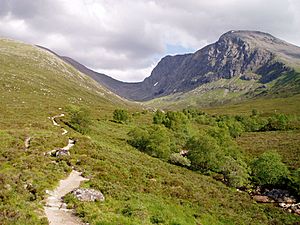
Highland Council Area
The Highland Council area was created in 1996. It is a single council area. This council area does not include a large part of the southern and eastern Highlands, or the Western Isles. But it does include Caithness. Sometimes, "Highlands" is used to mean just this council area. For example, the old Highlands and Islands Fire and Rescue Service covered this area. Signs in the Pass of Drumochter say "Welcome to the Highlands."
Highlands and Islands
Much of the Highlands overlaps with the Highlands and Islands area. This is an electoral region used for elections to the Scottish Parliament. This area includes Orkney and Shetland, the Highland Council area, the Western Isles, and most of Argyll and Bute and Moray. However, "Highlands and Islands" can mean different things in different situations. For example, the old Northern Constabulary police force covered the same area as the fire and rescue service.
Travel and Delivery
There have been paths from the Lowlands to the Highlands since ancient times. Many cross the Mounth, a mountainous area that stretches to the North Sea. Important paths include the Causey Mounth and Elsick Mounth.
Even though most of the Highlands is on the British mainland, it's harder to reach than other parts of Britain. Because of this, many UK delivery companies charge extra fees for sending packages there. They often treat it like Northern Ireland or the Isle of Man. This can be confusing because some areas that are not very remote still get these extra charges. Royal Mail is the only delivery service that charges the same price across the whole UK for mail items. However, this does not apply to larger packages handled by its Parcelforce division.
Geology of the Highlands
The Highlands are located north and west of the Highland Boundary Fault. This part of Scotland is mostly made of very old rocks from the Cambrian and Precambrian periods. These rocks were pushed up during the Caledonian Orogeny, a time when mountains were formed. Some of the oldest rocks, called Lewisian gneiss, in the northwest are up to 3 billion years old!
Over these old rocks are layers of Torridon Sandstone. These form mountains like Liathach and Beinn Eighe in Wester Ross. There are also many younger igneous rocks that have pushed through. These form mountain areas like the Cairngorms and the Cuillin on Skye.

An important exception is the Old Red Sandstone, which has fossils. It is found along the Moray Firth coast. The Jurassic rocks found on Skye and Applecross show how complex the rocks underneath are. They are the original source of much of the North Sea oil. The Great Glen is a large valley formed along a transform fault. This fault divides the Grampian Mountains from the Northwest Highlands.
The entire region was covered by ice sheets during the Pleistocene ice ages. The landscape has deep valleys and lochs (lakes) carved by streams and ice. The mountains have similar heights at their tops, but their bases vary depending on how much the land has been worn away.
Climate
The Highlands are much warmer than other places at the same latitude, like parts of Russia or Canada. This is because of the Gulf Stream, which brings warm water from the ocean. The climate is generally cool, damp, and temperate. At lower elevations, it's an "Cfb" climate. At higher elevations, it becomes "Cfc", "Dfc", and even "ET" (very cold, treeless areas).
Places to Visit
- An Teallach
- Aonach Mòr (Nevis Range ski centre)
- Arrochar Alps
- Balmoral Castle
- Battlefield of Culloden
- Ben Nevis (highest mountain in Scotland and UK)
- Cairngorms National Park
- Caledonian Canal
- Cape Wrath
- Castle Stalker
- Eilean Donan
- Glen Coe
- Glenfinnan (and its viaduct)
- Highland Folk Museum – The first open-air museum in the UK.
- Highland Wildlife Park
- Inveraray Castle
- Inverness Castle
- Loch Ness
- Loch Lomond and the Trossachs National Park
- Rannoch Moor
- Smoo Cave
- Urquhart Castle
- West Highland Line (scenic railway)
- West Highland Way (Long-distance footpath)
Gallery
-
The Glenfinnan Viaduct from below.
-
Loch Scavaig, Isle of Skye.
-
The islands of Loch Maree.
-
The interior of Smoo Cave, Sutherland.
-
Cape Wrath Lighthouse in the far NW of the Highlands.
-
The Quirang, Isle of Skye.
-
Highland Cattle originates from the Scottish Highlands.
See also
 In Spanish: Tierras Altas de Escocia para niños
In Spanish: Tierras Altas de Escocia para niños


